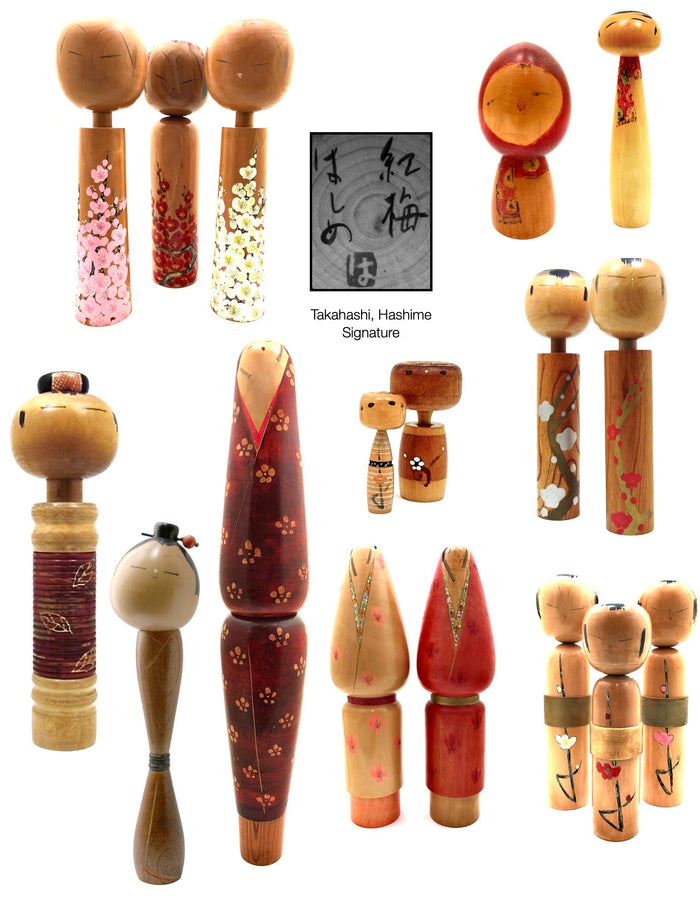

Vintage Sosaku Kokeshi entitled “Korin | After Ogata Korin” by Takahashi, Hashime (1918-2002)
Dimensions: 14-1/2” h
Takahashi-san’s artistic background as a painter includes time spent as a craftsman of ‘Yuzen’, a silk kimono dying. He is a multiple-award winner in yearly Kokeshi competitions, receiving the Prime Minister’s Award, the highest honor bestowed on Sosaku Kokeshi artists.
This exceptional and RARE Kokeshi pays homage to Ogata Korin, who was born in 1658, and was a Japanese artist of the Tokugawa period. He is regarded as one of the masters of the Sotatsu-Koetsu school of decorative painting. An accomplished painter, he employed Japanese subject matter with a colorful, decorative style. He also was an expert lacquer artist, whose work has had a tremendous influence on Kokeshi craftsmen such as Takahashi-san, and others working in the field.
Takahashi, as influenced by Korin, is famous for his textile designs and pictorial decorations now interpreted on Kokeshi wooden forms, as this piece pictures abstract bold, red-colored Plum Blossoms and tree branches on a natural Ash, (Kaibun), wood-patterned background. The wonderfully- proportioned head is perched on a bold and solid neck that joins this element with the body of the doll. The face is very expressive, with horizontal, slanted eyes, and a wisp of black bang on top of the head with side fringes. Takahashi-san titled, signed in script and placed his Hanko on the bottom of the doll.
The piece was published in the 2022 publication of Sosaku Kokeshi: Celebrating the Major Artists of the Creative Movement. For more information on this artist go to the following link: https://mingeiarts.com/collections/artisan-woodworker-takahashi-hashime-1918-2002.
Condition: Excellent, lathe-turned creation and size, for it is outstanding, impressive, and beautiful. No chips, cracks, breaks, missing pieces, or restoration, and retains its original details and finish. The piece meets all the standards of the vintage collectible Sosaku Kokeshi by Takahashi, Hashime.

Artisan
Woodworker: Takahashi, Hashime
1918-2002
Biographical History:
Takahashi Hashime was originally a fine artist/painter. He is known for his colorful designs and the use of brush strokes. Takahashi-san is from Sendai, (where Traditional Kokeshi were born), in Miyagi Prefecture. His artistic background also includes time spent as a craftsman of Yuzen silk kimono dying which is why Kimono is a focus on all of his dolls. He is a multiple award winner in yearly Kokeshi competitions, receiving the Prime Minister’s Award, the highest honor bestowed on Sosaku Kokeshi artists. All of his work is easily recognized producing unique forms and details. Now deceased, his son, Akinori is carrying on the family’s tradition, but in limited production.
Collector's note – descriptive qualities, standard characteristics & ornamentation styles:
The most unusual quality of his dolls is that their heads are treated as a separate element which in many cases are a simple tapered element between the head and the body of the doll. The artist motif‘s range from realistic seasonal flowers such as abstract Plum flowers, (Ume), Cherry blossoms, (Sakura), and Japanese Iris, (Ayame), or celebrating zodiac figures representing one of twelve specific constellations of the zodiac, which over time took on diverse meanings. Takahashi-san has a beautiful pictorial approach to illustrating kimono in a very refined painterly way. He shows both painted and carved Kimono, Obi with exaggerated waists and supportive under and over garments such as scarves and sashes. His use of Rokuro Moyo is occasionally seen in carved and painted forms. Last but not least, are the detailing of faces, all having expressive eyes, small dot noses and wisps of hair. His use of Rokuro Moyo is occasionally seen in both carved and painted forms.
Explore & Learn More about Woodworker: Takahashi, Hashime